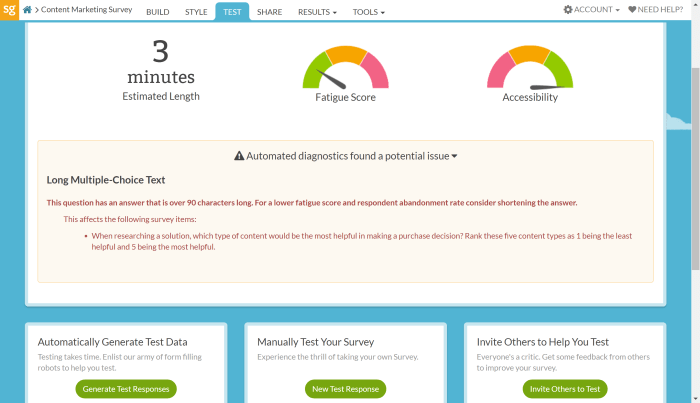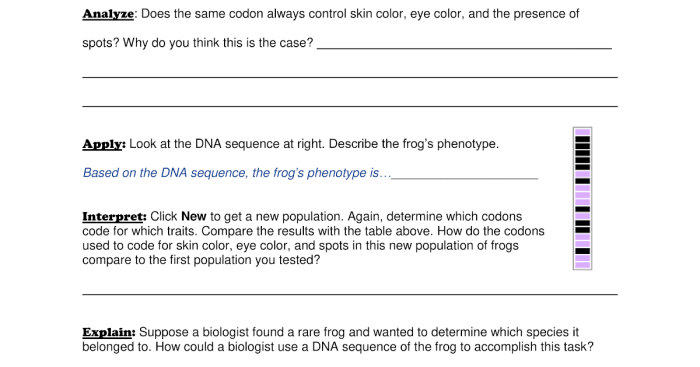Embark on a captivating journey into the realm of DNA analysis with our comprehensive guide to the DNA Analysis Gizmo Answer Key. This essential resource unlocks the mysteries of genetics, providing an engaging and accessible exploration of DNA structure, analysis techniques, and real-world applications.
Delving into the fundamentals of DNA, we unravel the intricate dance of nucleotides and base pairs, revealing the secrets encoded within our genetic blueprint. Our exploration extends to the cutting-edge techniques of DNA extraction and sequencing, empowering you to understand the principles and applications that drive genetic research.
DNA Structure and Analysis

DNA, or deoxyribonucleic acid, is the hereditary material in humans and almost all other organisms. It is a molecule that contains the instructions for an organism’s development and characteristics.
DNA is made up of four different types of nucleotides: adenine (A), thymine (T), cytosine (C), and guanine (G). These nucleotides are arranged in a specific order, which determines the genetic code. The genetic code is read by cells to produce proteins, which are the building blocks of the body.
Role of DNA Analysis
DNA analysis is a powerful tool that can be used to understand genetic information. DNA analysis can be used to:
- Identify individuals
- Diagnose genetic diseases
- Study evolution
- Develop new medical treatments
DNA Extraction and Techniques: Dna Analysis Gizmo Answer Key

DNA extraction is a crucial step in many molecular biology techniques, enabling the isolation and purification of DNA from biological samples. Various methods are employed for DNA extraction, each with its advantages and applications.
Gel Electrophoresis
Gel electrophoresis is a technique used to separate DNA fragments based on their size and charge. DNA samples are loaded onto a gel matrix and subjected to an electric field. Smaller DNA fragments migrate faster through the gel, while larger fragments move more slowly.
This allows for the separation and visualization of DNA fragments of different sizes, which is useful for various applications such as DNA fingerprinting and genetic diagnostics.
Polymerase Chain Reaction (PCR)
PCR is a technique used to amplify specific DNA sequences exponentially. It involves a series of temperature cycles that denature the DNA, anneal primers to complementary sequences, and extend the primers using a DNA polymerase enzyme. PCR allows for the amplification of even minute amounts of DNA, making it a powerful tool for various applications such as DNA cloning, genetic testing, and forensic analysis.
DNA Sequencing Technologies
DNA sequencing technologies are used to determine the order of nucleotides in a DNA molecule. These technologies have revolutionized the field of genomics, enabling the study of genes, genomes, and genetic variations.
- Sanger sequencing: This method uses dideoxynucleotides (ddNTPs) to terminate DNA synthesis, resulting in a series of DNA fragments of varying lengths. These fragments are then separated by gel electrophoresis and analyzed to determine the DNA sequence.
- Next-generation sequencing (NGS): NGS technologies, such as Illumina sequencing and Ion Torrent sequencing, use massively parallel sequencing to generate millions of DNA sequences simultaneously. These technologies are faster and more cost-effective than Sanger sequencing, making them suitable for large-scale genome sequencing projects.
To unravel the mysteries of DNA, the DNA Analysis Gizmo Answer Key provides invaluable insights. This key unlocks the secrets of genetic codes, enabling researchers to decode the intricate patterns that shape life. As you delve into the complexities of DNA, take a detour to explore the enigmatic realm of the Way in China Crossword . This puzzle challenges your knowledge of Chinese culture and language, inviting you to navigate its unique linguistic landscape.
With each step in both the DNA Analysis Gizmo and the crossword, you’ll expand your understanding of science and culture.
DNA Profiling and Applications

DNA profiling is a technique used to identify individuals by analyzing their unique DNA sequences. It is commonly used in forensic science to identify suspects, victims, and missing persons. DNA profiling can also be used in paternity testing, ancestry tracing, and medical diagnosis.
Ethical Considerations and Privacy Concerns, Dna analysis gizmo answer key
The use of DNA profiling raises several ethical and privacy concerns. One concern is the potential for discrimination based on genetic information. For example, an individual’s genetic profile could be used to predict their risk of developing certain diseases or to identify genetic predispositions to certain behaviors.
This information could be used to make decisions about employment, insurance, or other aspects of life.
Another concern is the potential for DNA profiling to be used for surveillance or tracking. For example, DNA profiling could be used to track individuals’ movements or to identify individuals who have been in contact with a particular person. This information could be used for law enforcement purposes, but it could also be used for more nefarious purposes, such as stalking or harassment.
Bioinformatics and Data Analysis
![]()
Bioinformatics plays a pivotal role in the analysis of DNA data, facilitating the interpretation of complex genetic information. It employs computational tools and techniques to decipher DNA sequences, identify patterns, and extract meaningful insights.
Tools and Techniques for DNA Sequence Analysis
The analysis of DNA sequences involves a suite of specialized tools and techniques:
- Sequence alignmentcompares multiple DNA sequences to identify regions of similarity and divergence.
- Phylogenetic analysisreconstructs evolutionary relationships between organisms based on DNA sequence comparisons.
- Genome annotationidentifies and characterizes genes, regulatory elements, and other functional regions within DNA sequences.
- Data visualizationtools enable the exploration and interpretation of large and complex DNA datasets.
li> Variant callingdetects genetic variations, such as single nucleotide polymorphisms (SNPs), insertions, and deletions, within DNA sequences.
Educational Resources
DNA analysis is a vast and rapidly evolving field, and there are a wealth of resources available for students and teachers who want to learn more about it. These resources include textbooks, online courses, and interactive simulations.
One of the most popular resources for learning about DNA analysis is the Gizmo answer key. The Gizmo answer key is a set of step-by-step instructions that can help students complete the Gizmo DNA analysis simulation. The Gizmo answer key is a valuable learning tool because it provides students with a clear understanding of the steps involved in DNA analysis and how to interpret the results.
Effectiveness of Gizmo Answer Key
The Gizmo answer key is an effective learning tool because it provides students with a clear understanding of the steps involved in DNA analysis and how to interpret the results. The answer key is written in a clear and concise style, and it is easy to follow.
The answer key also includes helpful tips and tricks that can help students complete the simulation more quickly and efficiently.
Q&A
What is the DNA Analysis Gizmo?
The DNA Analysis Gizmo is an interactive simulation that allows students to explore the principles of DNA analysis in a virtual laboratory setting.
How can I use the DNA Analysis Gizmo Answer Key?
The DNA Analysis Gizmo Answer Key provides step-by-step solutions to the Gizmo activities, helping students to understand the concepts and procedures involved in DNA analysis.
What are the benefits of using the DNA Analysis Gizmo?
The DNA Analysis Gizmo provides a hands-on and engaging way to learn about DNA analysis, making it an effective tool for both students and educators.
